英语时间介词的用法
英语时间介词的用法大全
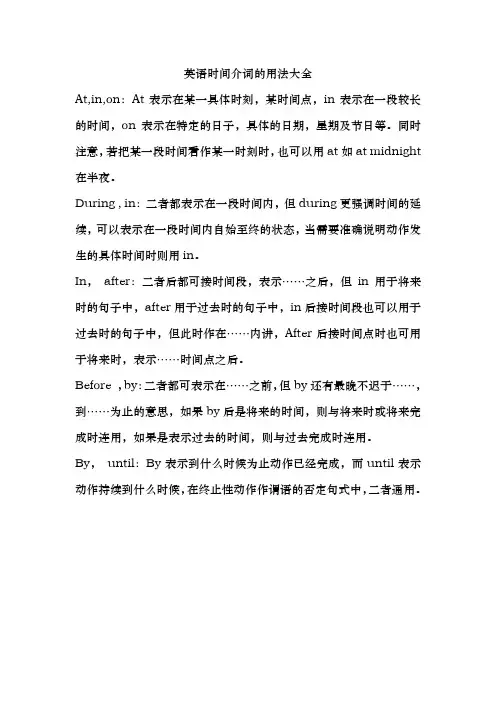
英语时间介词的用法大全
At,in,on:At表示在某一具体时刻,某时间点,in表示在一段较长的时间,on表示在特定的日子,具体的日期,星期及节日等。
同时注意,若把某一段时间看作某一时刻时,也可以用at如at midnight 在半夜。
During , in:二者都表示在一段时间内,但during更强调时间的延续,可以表示在一段时间内自始至终的状态,当需要准确说明动作发生的具体时间时则用in。
In,after:二者后都可接时间段,表示……之后,但in用于将来时的句子中,after用于过去时的句子中,in后接时间段也可以用于过去时的句子中,但此时作在……内讲,After后接时间点时也可用于将来时,表示……时间点之后。
Before ,by:二者都可表示在……之前,但by还有最晚不迟于……,到……为止的意思,如果by后是将来的时间,则与将来时或将来完成时连用,如果是表示过去的时间,则与过去完成时连用。
By,until:By表示到什么时候为止动作已经完成,而until表示动作持续到什么时候,在终止性动作作谓语的否定句式中,二者通用。
英语介词中时间介词的用法
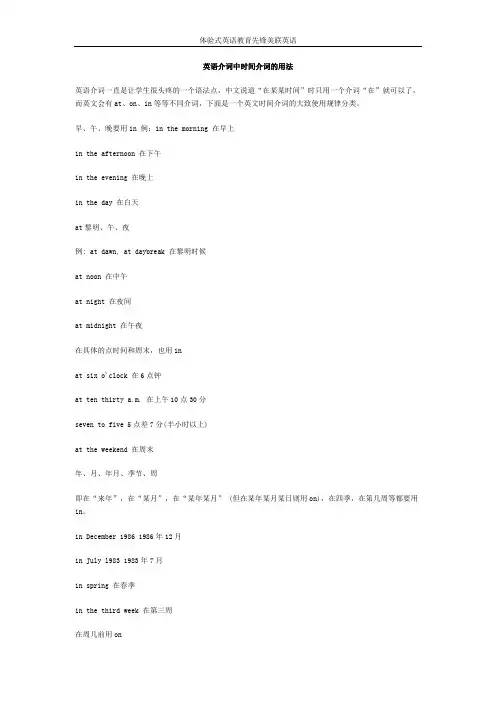
英语介词中时间介词的用法
英语介词一直是让学生很头疼的一个语法点,中文说道“在某某时间”时只用一个介词“在”就可以了,而英文会有at、on、in等等不同介词,下面是一个英文时间介词的大致使用规律分类。
早、午、晚要用in 例:in the morning 在早上
in the afternoon 在下午
in the evening 在晚上
in the day 在白天
at黎明、午、夜
例: at dawn, at daybreak 在黎明时候
at noon 在中午
at night 在夜间
at midnight 在午夜
在具体的点时间和周末,也用in
at six o'clock 在6点钟
at ten thirty a.m. 在上午10点30分
seven to five 5点差7分(半小时以上)
at the weekend 在周末
年、月、年月、季节、周
即在“来年”,在“某月”,在“某年某月” (但在某年某月某日则用on),在四季,在第几周等都要用in。
in December 1986 1986年12月
in July l983 1983年7月
in spring 在春季
in the third week 在第三周
在周几前用on
on Monday
on Sunday
周几和早、中、晚连用是是遵循“就近原则”(就是以第一个词为主)用on on Monday morning
on Sunday evening。
in on at做时间介词的用法 -回复
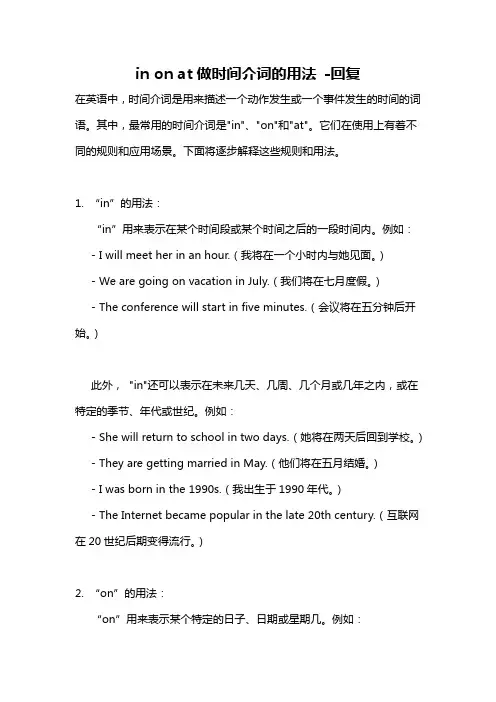
in on at做时间介词的用法-回复在英语中,时间介词是用来描述一个动作发生或一个事件发生的时间的词语。
其中,最常用的时间介词是"in"、"on"和"at"。
它们在使用上有着不同的规则和应用场景。
下面将逐步解释这些规则和用法。
1. “in”的用法:“in”用来表示在某个时间段或某个时间之后的一段时间内。
例如:- I will meet her in an hour.(我将在一个小时内与她见面。
)- We are going on vacation in July.(我们将在七月度假。
)- The conference will start in five minutes.(会议将在五分钟后开始。
)此外,"in"还可以表示在未来几天、几周、几个月或几年之内,或在特定的季节、年代或世纪。
例如:- She will return to school in two days.(她将在两天后回到学校。
)- They are getting married in May.(他们将在五月结婚。
)- I was born in the 1990s.(我出生于1990年代。
)- The Internet became popular in the late 20th century.(互联网在20世纪后期变得流行。
)2. “on”的用法:“on”用来表示某个特定的日子、日期或星期几。
例如:- I have a meeting on Monday.(我星期一有个会议。
)- Our anniversary is on March 15th.(我们的纪念日是在3月15日。
)- The concert will be held on Friday.(音乐会将在星期五举行。
)此外,“on”还可用于特定的假日或节日。
例如:- We celebrate Christmas on December 25th.(我们在12月25日庆祝圣诞节。
关于时间前的介词用法
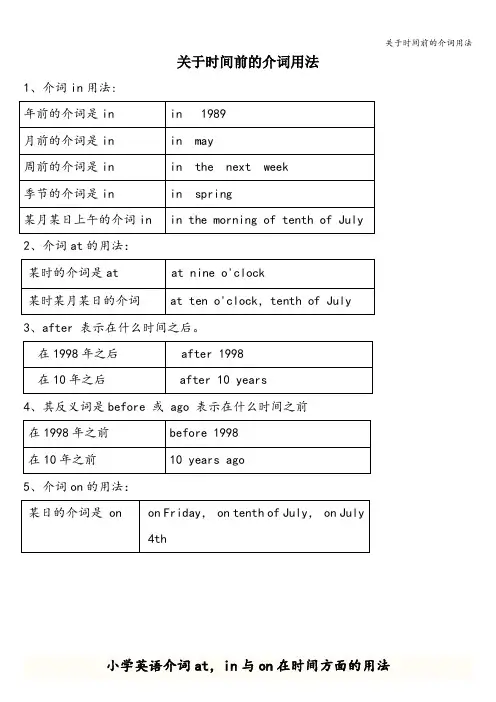
关于时间前的介词用法1、介词in用法:2、介词at的用法:3、after 表示在什么时间之后。
4、其反义词是before 或 ago 表示在什么时间之前5、介词on的用法:小学英语介词at,in与on在时间方面的用法at表示时间的一点; in表示一个时期; on表示特殊日子。
如: He goes to school at seven o'clock in the morning. 他早晨七点上学。
Can you finish the work in two days。
你能在两天内完成这个工作吗? Linda was born on the second of May。
琳达五月二日出生。
1〉。
at后常接几点几分,天明,中午,日出,日落,开始等。
如:at five o’clock (五点),at down (黎明),at daybreak (天亮),at sunrise (日出),at noon (中午),at sunset (日落),at midnight (半夜),at the beginning of the month (月初),at that time (那时)at that moment (那会儿),at this time of day (在一天的这个时候).2>. in后常接年,月,日期,上午,下午,晚上,白天,季节,世纪等。
如: in 2006(2006年),in May,2004 (2004年五月),in the morning (早晨/上午),in the afternoon (下午),in the evening (晚上),in the night (夜晚),in the daytime (白天),in the 21st century (21世纪),in three days (weeks/month)三天(周/个月),in a week (一周),in spring (春季)。
(完整版)小学英语常用介词及用法
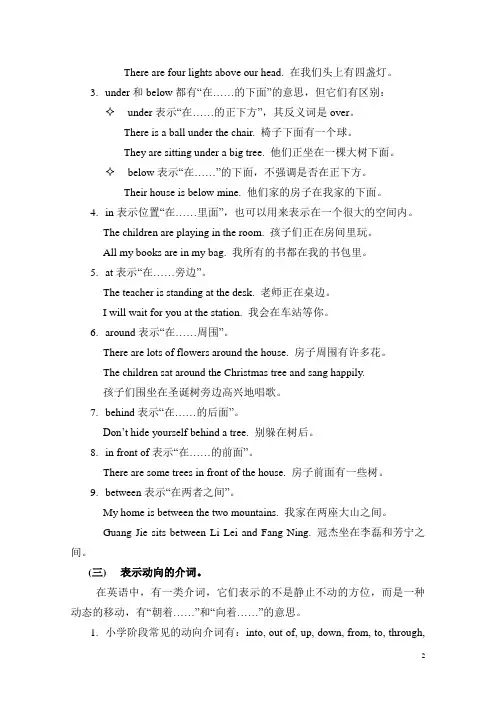
常见介词及用法(一)表示时间的介词1.英语里最常见的时间介词有:at, in, on, before, after和from。
2.at , in和on这三个词都表示时间。
✧at主要指具体的钟点:at half past eight 在八点半✧in一般指某一段时间:in January 在一月份✧on指具体在某一天:on Monday 在星期一3.before和after表示时间的先后顺序。
✧before表示“在……之前”。
You should wash your hands before eating. 吃饭前你应该洗手。
✧after表示“在……之后”。
They often play basketball after dinner. 他们放学后经常打篮球。
4.from作时间介词含有“从……开始”的意思,常和to连用,组成“from…to…”的结构,表示“从……到……”的意思。
We go to school from Monday to Friday. 我们从周一到周五上学。
(二)表示方位的介词,也就是表示位置和地点的介词。
1.小学阶段常见的方位介词有:on, in, at, under, over, above, below, about,around, between等。
2.on, over和above这三个词都有“在……上面”的意思,但它们所表示的方位还是有些不同。
✧on表示两个物体的表面相互接触。
如:There is a book on the desk. 桌上有一本书。
The boy is sleeping on the desk. 那个孩子睡在地上。
✧over表示“在……的正上方”,两个物体表面没有接触。
如:There is a light bulb over my head. 在我头顶上有一个灯泡。
✧above表示两个物体中一个在另一个的上方,如:The plane is flying above the clouds. 飞机上云层上飞行。
英语介词的使用
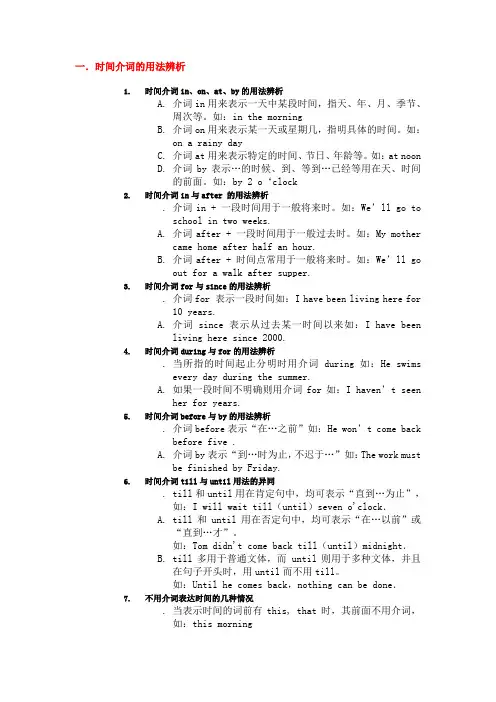
一.时间介词的用法辨析1.时间介词in、on、at、by的用法辨析A.介词in用来表示一天中某段时间,指天、年、月、季节、周次等。
如:in the morningB.介词on用来表示某一天或星期几,指明具体的时间。
如:on a rainy dayC.介词at用来表示特定的时间、节日、年龄等。
如:at noonD.介词by表示…的时候、到、等到…已经等用在天、时间的前面。
如:by 2 o‘clock2.时间介词in与after 的用法辨析.介词in + 一段时间用于一般将来时。
如:We’ll go toschool in two weeks.A.介词after + 一段时间用于一般过去时。
如:My mothercame home after half an hour.B.介词after + 时间点常用于一般将来时。
如:We’ll goout for a walk after supper.3.时间介词for与since的用法辨析.介词for 表示一段时间如:I have been living here for10 years.A.介词since 表示从过去某一时间以来如:I have beenliving here since 2000.4.时间介词during与for的用法辨析.当所指的时间起止分明时用介词during如:He swimsevery day during the summer.A.如果一段时间不明确则用介词for如:I haven’t seenher for years.5.时间介词before与by的用法辨析.介词before表示“在…之前”如:He won’t come backbefore five .A.介词by表示“到…时为止,不迟于…”如:The work mustbe finished by Friday.6.时间介词till与until用法的异同.till和until用在肯定句中,均可表示“直到…为止”,如:I will wait till(until)seven o'clock.A.till和until用在否定句中,均可表示“在…以前”或“直到…才”。
(完整版)英语中介词的用法
介词的用法一、表示时间日期的介词1.at:主要表示方向、场所、时间的某一点at the corner of the street,at dinner,at sixty miles an hour,be sold at three yuan a dozen,come at us固定搭配:at one time,at the beginning of,at the post office,at the airport,at the weekend,at the age of25,at the same time,at present,at any time,表示原因,表示“见/闻……而”。
at the news at主要表示时间点表示特定的时间at night a.m.在九点钟表示不确定的时间at night,at that time,at Christmas 在圣诞期间当天on表示年龄段at the age of eight在8岁2.in:表示场所、时间与期限、状况、方向。
主要用来表示较长的时间单位,如月份、季节、年份等in the1990s in the late19th century形成“in+时段名词”的词组或固定搭配in those days,in the daytime,in a short while,in no time,in time.in主要表示时间段一般指相对较长的时间段里in the morning,in spring,in the past ten years在…时间之后,用于将来时He will be back in a month.介词in在短语或句型中的省略:1)某些形容词/过去分词后接v-ing形式时,v-ing形式前的介词in可以省略。
be busy(in)doing be engaged(in)doing(忙于……)2)某些动词如busy等,常与反身代词连用,其后的in也可以省略。
表示时间介词用法
What does Jim often do on Monday
Xiaoyan: I’ve got my fitness program from the gym for this
month. Which
Mary: ⑴
class do you have tomorrow, Xiaoyan
Xiaoyan: ToWmohrorow-Tuesday-I haven’t got a class. I do gym.
一般疑问句
简略回答
Was I…
Yes, I was.
No, I wasn’t.
Were you…
Yes, we were. No, we weren’t.
Was he/she/it… Yes, he/she/it was. No, he/she/it wasn’t.
Were we…
Yes, we were. No, we weren’t.
*注意:具体某天的上午、下午或晚上要用介词on,如: They will have dinner together on Sunday evening.
*注意:以下名词与介词的固定搭配: My children play in the street in the daytime. (在
白天) I can hear the cars at night. (在晚上) I go to my mother’s house at the weekend. (在周
比较级\最高级的规则及不规则变化
▪ 1 ---er/est ▪ Tall-taller-tallest, short-shorter-shortest ▪ 2. 以e结尾-r/st nice-nicer-nicest ▪ 3.重读闭音节,双写辅音字母-er/est ▪ thin-thinner-thinnest ▪ 4.已辅音字母+y结尾 去y变I-er/est ▪ busy-busier-busiest ▪ 5.多音节形容词—more/most ▪ Relaxed---more relaxed---most relaxest ▪ Note: good-better-best bad-worse-worst
英语中时间介词的用法和区别
介词的用法与区别
1,时间或地点介词in、on、at的区别,表示时间时,in表示在一段时间里(在将来时句子中则表示在一段时间后),on表示在
具体的某一天或者某天的上下午等,at表示在某个时刻或者瞬
间。
表示地点时,in表示在某个范围之内,on表示在某个平面
上或与一个面相接处,at则表示在某个具体的场所或地点。
如:He was born on the morning of May 10th.他出生于五月十日的早
晨。
I usually get up at 7:00 in the morning .我通常在早上七点钟
起床。
His glasses are right on his nose .他的眼睛就架上他的鼻子
上。
He is at the cinema at the moment .此刻他正在电影院。
2,after与in表示时间的区别after+(具体时刻/从句)表示“在…时刻之后”常用于一般时态;“i n+(一段时间)”表示“在(多
久)之后”,常用于将来时态。
如:He said that he would be here after 6:00.他说他六点之后会来这儿. My father is coming back from England in about a month .我父亲大约一
个月以后从英国回来。
时间介词的用法口诀
时间介词的用法口诀
时间介词,在句中表时,
关注下文需用何时,
On 与at 及in 比较清,
让我们来学习这门课。
On 用于日子及特定日,
例如星期日与圣诞节,
具体的时刻用at 表示,
如早上七点或午夜。
In 与年代及季节连,
冬天夏季皆可适宜,
月份、年份也适宜,
如in July 或in 2022。
On 表示在星期或日期,
At 表示具体某时刻,
In 用来表示年月日,
时间介词记牢不迟疑。
除了以上基本规则,还有部分特殊用法需要特别注意。
例如,在表示“在……以内” 的意思时,通常会用介词 within 而非 in。
又如,表示“在……之前” 的情况下,我们会使用介词 before,而不是 in。
此外,介词的选择也会受到习惯表达方式的影响,所以在实际运用中还需根据具体情境适时灵活变通。
总之,在学习英语时间介词的使用时,不妨多做练习,注重细节,通过实际操作来巩固记忆。
熟练掌握时间介词的使用是提高英语写作和口语表达能力的重要一步,希望以上口诀能够帮助大家更好地理解和掌握时间介词的正确用法。
1。
- 1、下载文档前请自行甄别文档内容的完整性,平台不提供额外的编辑、内容补充、找答案等附加服务。
- 2、"仅部分预览"的文档,不可在线预览部分如存在完整性等问题,可反馈申请退款(可完整预览的文档不适用该条件!)。
- 3、如文档侵犯您的权益,请联系客服反馈,我们会尽快为您处理(人工客服工作时间:9:00-18:30)。
英语时间介词的用法
表示时间的介词
1)in ,on, at 在……时
一.in, on在方位名词前的区别
1.in表示A地在B地范围之内.如:
Taiwan is in the southeast of China.
2.on表示A地与B地接壤、毗邻.如:
North Korea is on the east of China.
二.at, in, on在表示时间上的区别
1.at指时间表示:
(1)时间的一点、时刻等.如:
They came home at sunrise (at noon, at midnight, at ten o’clock, at daybreak,at dawn).
(2)较短暂的一段时间.可指某个节日或被认为是一年中标志大事的日子.如:He went home at Christmas (at New Year, at the Spring Festival, at night). 2.in指时间表示:
(1)在某个较长的时间(如世纪、朝代、年、月、季节以及泛指的上午、下午或傍晚等)内.如:
in 2004,in March, in spring, in the morning, in the evening, etc
(2)在一段时间之后.一般情况下,用于将来时,谓语动词为瞬间动词,意为“在……以后”.如:
He will arrive in two hours.
谓语动词为延续性动词时,in意为“在……以内”.如:
These products will be produced in a month.
注意:after用于将来时间也指一段时间之后,但其后的时间是“一点”,而不是“一段”.如:
He will arrive after two o’clock.
3.on指时间表示:
(1)具体的时日和一个特定的时间,如某日、某节日、星期几等.如:
On Christmas Day(On May 4th),there will be a celebration.
(2)在某个特定的早晨、下午或晚上.如:
He arrived at 10 o’clock on the night of the 5th.
(3)准时,按时.如:
If the train should be on time,I should reach home before dark.
三.at,in和on表示地点时的区别
1.at表示地点:
(1)用于指较小的地方.如:
I shall wait for you at the station.
(2)用于门牌号码前.如:
He lives at 115 Zhongshan Road.
2.in表示地点:
(1)用于指较大的地方.如:
He lives in Shanghai.
(2)虽然是很小的地方,如果说话人住在那里,也可用in.商店、学校、机关等,若
看作一个地点(point)用at,若看作一个场所(place)用in.如:
I met him at the post-office.
I’m now working in the post-office.
3.on表示地点,一般指与面或线接触,意为“在……上;在……旁”.如:The picture was hanging on the wall.
New York is on the Hudson River.
口诀1:
年月周前要用in,
日子前面却不行。
遇到几号要用on,
上午下午又是in。
要说某日上下午,
用on换in才能行。
午夜黄昏用at,
黎明用它也不借。
at也在时分前,
说“差”用to,
说“过”要用part。
口诀2:
in在……里,
out在……外,
在旁边的是beside,
靠近的为by 。
on在……上,
under在……下,
above在上头,
below在底下。
口诀3:
this、that、tomorrow,yesterday,next、last、one。
接年、月、季、星期、周,介词省略已习惯。
over、under正上下,above、below则不然,
若与数量词连用,混合使用亦无关。
'
beyond超出、无、不能,against靠着,对与反。
besides,except分内外,among之内along沿。
同类比较except,加for异类记心间。
口诀4:
before、after表一点, ago、later表一段。
before能接完成时,ago过去极有限。
since以来during间,since时态多变换。
与之相比beside,除了last but one。
口诀5:
①早、午、晚要用in
例:in the morning 在早上
in the afternoon 在下午
in the evening 在晚上
in the day 在白天
②黎明、午、夜、点与分用at
例: at dawn, at daybreak 在黎明时候
at noon 在中午
at night 在夜间
at midnight 在午夜
at six o'clock 在6点钟
at 7:30 (seven thirty) 在7点半
at half past eleven 在11点半
at nine fifteen 在9点15分
at ten thirty a.m. 在上午10点30分
at the weekend 在周末
③年、月、年月、季节、周用in。
例;in 1986 在1986年
in 1927 在1927年
in april 在四月
in march 在三月
in december 1986 1986年12月
in july l983 1983年7月
in spring 在春季in summer 在夏季
in autumn 在秋季in winter 在冬季
in the fist week of this semester 这学期的第一周in the third week 在第三周。
